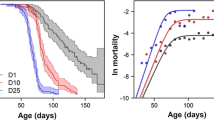Summary
Life-history variation was examined among members of theDaphnia longispina group, which consists ofD. galeata, D. hyalina, D. cucullata, and hybrids. Factorial experiments were conducted at two temperatures (14° and 20° C) and two food concentrations (0.2 and 1.0 mg Cl−1). Differences in life-history features (size at maturity, age at first reproduction, size of first clutch, offspring size in first clutch) under the different environmental conditions were assessed among eightDaphnia clones, which represented members of this species complex. Significant differences between parentals and hybrids for most life-history features were observed under various treatments; generally, hybrid clones showed intermediate life-history traits when compared with parentals. When comparisons were made among clones within a given species (i.e.D. galeata, D. galeata xcucullata, D. cucullata), clonal differences were also noted for certain life-history traits. The data are discussed with reference to the formation and maintenance of hybrid species complexes in nature.
Similar content being viewed by others
References
Agar WE (1920) The genetics of aDaphnia hybrid during parthenogenesis. J Genet 10:303–330
Barton NH, Hewitt GM (1985) Analysis of hybrid zones. Ann Rev Ecol Syst 16:113–148
Falconer DS (1981) Introduction to quantitative genetics, 2nd edn. Longman, New York
Hann BJ (1987) Naturally occurring interspecific hybridization inSimocephalus (Cladocera, Daphniidae): its potential significance. Hydrobiologia 145:219–224
Hebert PDN (1985) Interspecific hybridization between cyclic parthenogens. Evolution 39:216–220
Hebert PDN (1987) Genotypic characteristics of the Cladocera. Hydrobiologia 145:183–193
Hebert PDN, Schwartz SS, Hrbacek J (1989) Genotypic diversity in CzechoslovakianDaphnia. Heredity 62:207–216
Kruse S (1988) Tagesperiodische Vertikalwanderung vonDaphnia (Cladocera). Diploma thesis, University of Kiel, Kiel, FRG
Lampert W, Bohrer R (1984) Effect of food availability on the respiratory quotient ofDaphnia magna. Comp Biochem Physiol 78A:221–223
Lampert W, Schmitt RD, Muck P (1988) Vertical migration of freshwater zooplankton: test of some hypotheses predicting a metabolic advantage. Bull Mar Sci 43:620–640
Lieder U (1983) Introgression as a factor in the evolution of polytypical plankton Cladocera. Internat Rev Gesam Hydrobiol 68:269–284
Lieder U (1987) The possible origin ofDaphnia cucullata procurva Poppe 1887 in lakes of the Pomeranian lakeland by hybridization in the past. Hydrobiologia 145:201–211
Loaring JM, Hebert PDN (1981) Ecological differences among clones ofDaphnia pulex. Oecologia 51:162–168
Lynch M (1984) The limits to life history evolution inDaphnia. Evolution 38:465–482
Mayr E (1963) Animal species and evolution. Harvard University Press, Cambridge
Mort MA (1990) Coexistence ofDaphnia species and their hybrids: an experimental population genetics approach. Arch Hydrobiol 120:169–183
Mort MA, Wolf HG (1985) Enzyme variability in large-lakeDaphnia populations. Heredity 55:27–36
Mort MA, Wolf HG (1986) The genetic structure of large-lakeDaphnia populations. Evolution 40:756–766
Rice WR (1989) Analyzing tables of statistical tests. Evolution 43:223–225
Roughgarden J (1979) Theory of population genetics and evolutionary ecology: an introduction. MacMillan, New York
Shan RK, Frey DG (1983)Pleuroxus denticulatus andP. procurvus (Cladocera, Chydoridae) in North America: distribution, experimental hybridization. Can J Zool 61:1605–1617
Sokal RR, Rohlf FJ (1981) Biometry, 2nd edn. WH Freeman and Co., San Francisco
Stich HB, Lampert W (1984) Growth and reproduction of migrating and non-migratingDaphnia species under simulated food and temperature conditions of diurnal vertical migration. Oecologia 61:192–196
Weider LJ (1985) Spatial and temporal genetic heterogeneity in a naturalDaphnia population. J Plankton Res 7:101–123
Weider LJ (1987) Life-history variation among low-arctic clones of obligately parthenogeneticDaphnia pulex: a diploid-polyploid complex. Oecologia 73:251–256
White MJD (1978) Modes of speciation. WH Freeman and Co., San Francisco
Wolf HG (1987) Interspecific hybridization betweenDaphnia hyalina, D. galeata, andD. cucullata and seasonal abundances of these species and their hybrids. Hydrobiologia 145:213–217
Wolf HG, Carvalho GR (1989) Resting eggs of lakeDaphnia. II. In situ observations on the hatching of eggs and their contribution to population and community structure. Freshw Biol 22:471–478
Wolf HG, Mort MA (1986) Inter-specific hybridization underlies phenotypic variability inDaphnia populations. Oecologia 68:507–511
Wolf HG, Weider LJ (1991) Do life-history parameters ofDaphnia as determined in the laboratory correctly predict species successions in the field? Verh Internat Ver Limnol 24: (in press)
Author information
Authors and Affiliations
Additional information
This paper is dedicated to the memory of Hans Georg Wolf, who died suddenly in May 1990 at the age of 39 years.
Rights and permissions
About this article
Cite this article
Weider, L.J., Wolf, H.G. Life-history variation in a hybrid species complex ofDaphnia . Oecologia 87, 506–513 (1991). https://doi.org/10.1007/BF00320413
Received:
Accepted:
Issue Date:
DOI: https://doi.org/10.1007/BF00320413




